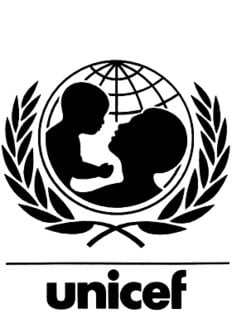United Nations Children's Fund
History
 Established by the United Nations General Assembly on December 11, 1946 and originally known as the United Nations International Children’s Emergency Fund (UNICEF), the UN Children’s Fund has employed three approaches in discharging its mandate.*
Established by the United Nations General Assembly on December 11, 1946 and originally known as the United Nations International Children’s Emergency Fund (UNICEF), the UN Children’s Fund has employed three approaches in discharging its mandate.*
For the postwar period 1946 to 1950, the “emergency needs approach” meant swift action to meet the food, clothing, and health needs of children, particularly in Europe. At an expenditure of $112,000,000, UNICEF distributed various articles of clothing to five million children in twelve countries, vaccinated eight million against tuberculosis, rebuilt milk processing and distribution facilities, and, at the climax of its effort in Europe, provided a daily supplementary meal to millions of children.
During the period 1951-1960, UNICEF continued to meet emergency needs, but at the same time moved into the long-range benefit approach. To protect the health of children, UNICEF conducted campaigns against tuberculosis, yaws, leprosy, and malaria; made provisions for environmental sanitation; encouraged maternal and child health care education. To raise nutritional standards for children, UNICEF helped countries produce and distribute low-cost, high-protein foods and fostered programs to educate people in their use. To provide for the social welfare of children, UNICEF instituted informal training of mothers in child rearing and home improvement, aided services for children through day-care and neighborhood centers, family counseling, and youth clubs. The expenditures totalled $150,000,000.
UNICEF broadened its policy during the 1961-1970 period by adopting a concept of allying aid for children to the development of the nation. In recognition of the interconnection between aspects of national policy and programs of aid to children, this approach, called the “country approach,” permitted UNICEF to implement in appropriate ways the priorities established by each nation in meeting the needs of its children. Consequently, becoming concerned with the intellectual, psychological, and vocational needs of children as well as with their physical needs, UNICEF provided assistance for teacher education and curriculum reform, allocated funds for pre-vocational training in usable skills, promoted information on the uses of technology. UNICEF projects, in short, reflected a comprehensive view of the child, seeing him as “a future agent for economic and social change.” In this decade UNICEF’s total expenditures were in excess of $300,000,000.
In the decade of the seventies, UNICEF will attempt to elevate the quality of life of children in the developing nations, coordinating its efforts with those of the governments concerned. UNICEF hopes to increase its assistance during the decade, aiming at an annual level of $100,000,000 by 1975, and to enlist complementary support from international, multinational, and nongovernmental agencies.
Stark statistics for UNICEF’s twenty-five-year history reveal only a facet of the constructive work accomplished, but they provide some indication of its scope: 71,000,000 children examined for trachoma and 43,000,000 treated; 425,000,000 examined for yaws and 23,000,000 treated; 400,000,000 vaccinated against tuberculosis, many millions protected from malaria, and 415,000 discharged as cured of leprosy; 12,000 rural health centers and several thousand maternity wards established in eighty-five countries; help given to provide equipment for 2,500 teacher training schools, 56,000 primary and secondary schools, 965 pre-vocational training schools, 31 schools for training pre-vocational instructors, 600 for training dietary personnel; equipment supplied for 4,000 nutrition centers and community gardens, and for 9,000 school gardens and canteens; equipment given to 2,500 day-care centers, 3,000 women’s clubs, and 3,500 community centers; supplementary meals dispensed in the billions and articles of clothing in the high millions; emergency aid furnished to hundreds of thousands victimized by floods, earthquakes, and other natural disasters.
Selected Bibliography
Films
UNICEF releases films for group showings. These films include four in English: Nomad Boy (Somalia), Beneath the Dreams (Hong Kong), Meet Tasani (Thailand), Starting from Scratch (United Republic of Tanzania); a number of Spanish versions of UNICEF films on Latin American countries; films produced by the European office – among them, two fifteen-minute documentaries, L’Eau Sauvage (Ceylon) and Le Chemin de la paix (Nigeria) and four short films on child life. Films scheduled for release in 1971 include a documentary on UNICEF, a documentary on problems of urbanization as it affects children, and one on the story of a UNICEF greeting card from design to sale.
General Progress Report of the executive Director. New York, United Nations (E/ICEF/ 608), 1971.
Heilbroner, Robert L., Mankind’s Children: The Story of UNICEF. New York, Public Affairs Committee, 1959.
Keeny, Spurgeon M., Half the World’s Children: A Diary of UNICEF at Work in Asia. New York, Association Press, 1957.
Progress Begins with the Child: Statement by the Executive Director to the Third Committee of the General Assembly, December, 1968. New York, United Nations (printed leaflet), 1969.
A Short Guide to UNICEF. New York, United Nations (UNICEF/Misc. 131), 1967. Strategy for Children: A Study of UNICEF Assistance Policies. New York, United Nations (E/ICEF/559/Rev. 1), 1967.
Yates, Elizabeth, Rainbow round the World: A Story of UNICEF. Indianapolis, Bobbs Merrill, 1954.
* Since the presentation speech, the acceptance speech, and the lecture provide historical information on UNICEF, this note is designed only to outline the main periods of UNICEF’s history, to update it to 1971, and, by using representative statistics, to summarize its contributions. The editor gratefully acknowledges the kindness of UNICEF in providing for his information a soon-to-be-issued history, but he is, of course, solely responsible for this note.
This text was first published in the book series Les Prix Nobel. It was later edited and republished in Nobel Lectures. To cite this document, always state the source as shown above.
Nobel Prizes and laureates
Six prizes were awarded for achievements that have conferred the greatest benefit to humankind. The 14 laureates' work and discoveries range from quantum tunnelling to promoting democratic rights.
See them all presented here.
